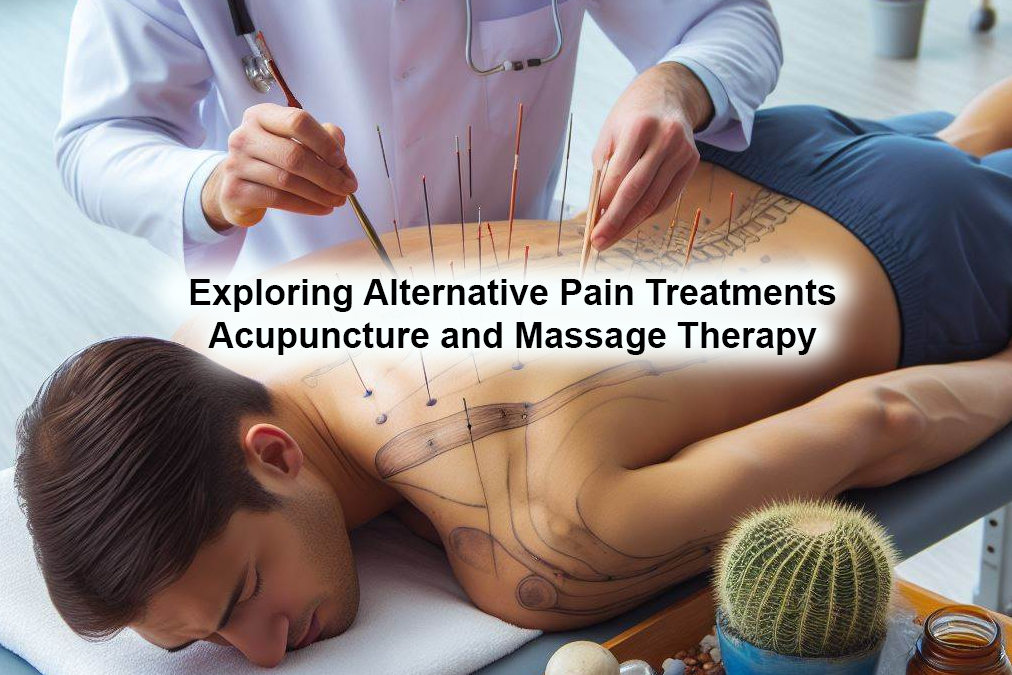Introduction
In recent years, there has been a growing interest in alternative treatments for pain management, with acupuncture and massage therapy emerging as popular choices. Both practices have roots in ancient healing traditions and are believed to offer relief from various types of pain. In this article, we’ll delve into the world of alternative pain treatments, focusing specifically on acupuncture and massage therapy. We’ll explore their origins, principles, effectiveness, and potential benefits for individuals seeking non-conventional approaches to pain relief.
Acupuncture: An Ancient Healing Art
History and Origins
Acupuncture, originating from Traditional Chinese Medicine (TCM), dates back thousands of years. It involves the insertion of thin needles into specific points on the body, known as acupuncture points or acupoints. The aim is to stimulate these points to correct imbalances in the flow of qi, or vital energy, within the body.
Principles and Mechanisms
According to TCM principles, pain and illness result from disruptions in the flow of qi along meridians, or energy channels, in the body. Acupuncture aims to restore balance and promote healing by unblocking these meridians and facilitating the smooth flow of qi. From a modern perspective, acupuncture may also trigger the release of endorphins, the body’s natural pain-relieving chemicals, and promote circulation to affected areas.
Effectiveness and Research
Numerous studies have explored the effectiveness of acupuncture for various types of pain, including chronic back pain, osteoarthritis, migraines, and fibromyalgia. While results have been mixed, many individuals report significant pain relief and improvement in their quality of life with acupuncture treatment. It’s important to note that individual responses to acupuncture may vary, and more research is needed to fully understand its mechanisms and effects.
Massage Therapy: A Hands-On Approach to Pain Relief
Origins and Evolution
Massage therapy has been practiced for centuries across different cultures, with its roots tracing back to ancient civilizations such as Egypt, China, and India. The practice involves the manipulation of soft tissues in the body, including muscles, tendons, and ligaments, to alleviate pain, reduce tension, and promote relaxation.
Techniques and Modalities
There are various massage techniques and modalities, each with its own approach and benefits. Some common types of massage include Swedish massage, deep tissue massage, sports massage, and trigger point therapy. These techniques may differ in pressure, speed, and focus areas, but they share the goal of relieving pain and enhancing overall well-being.
Benefits and Applications
Massage therapy offers a range of benefits beyond pain relief, including stress reduction, improved circulation, and enhanced flexibility. It can be used to address a wide range of conditions, from acute injuries and chronic pain to stress-related disorders and musculoskeletal issues. Many people incorporate regular massage sessions into their wellness routines to maintain physical and mental health.
Conclusion
Acupuncture and massage therapy represent two ancient yet enduring approaches to pain management and holistic healing. While their mechanisms may differ, both practices share a common goal of restoring balance and promoting well-being. Whether used alone or in combination with conventional treatments, acupuncture and massage therapy offer individuals alternative paths to pain relief and improved quality of life.
Table Summary
| Aspect | Acupuncture | Massage Therapy |
|---|---|---|
| Origin | Traditional Chinese Medicine (TCM) | Ancient civilizations worldwide |
| Technique | Insertion of thin needles | Manipulation of soft tissues |
| Principles | Restoration of qi flow | Alleviation of muscle tension and pain |
| Effectiveness | Mixed results in research | Widely recognized for pain relief |
| Benefits | Pain relief, improved well-being | Pain relief, stress reduction, improved circulation |
FAQ
1. Is acupuncture painful?
Acupuncture is generally well-tolerated, with many people reporting minimal discomfort during needle insertion. Sensations may vary from person to person, but they are often described as mild tingling or dull pressure.
2. How often should I receive massage therapy for pain relief?
The frequency of massage therapy sessions depends on individual needs and preferences, as well as the severity and type of pain. Some people benefit from weekly sessions, while others may find relief with less frequent treatments.
3. Are there any risks associated with acupuncture or massage therapy?
Both acupuncture and massage therapy are considered safe when performed by trained and licensed practitioners. However, some individuals may experience mild side effects such as bruising, soreness, or fatigue. It’s essential to communicate openly with your therapist and disclose any health concerns before treatment.
4. Can acupuncture and massage therapy be used together?
Yes, acupuncture and massage therapy can complement each other effectively. Some individuals choose to combine both treatments to address pain from multiple angles and enhance overall well-being.
5. How long do the effects of acupuncture and massage therapy last?
The duration of pain relief and other benefits may vary depending on factors such as the individual’s condition, treatment frequency, and lifestyle habits. Some people experience immediate relief that lasts for several days, while others may require ongoing maintenance sessions for long-term management.
6. Are there specific conditions that respond well to acupuncture or massage therapy?
Both acupuncture and massage therapy can benefit a wide range of conditions, including musculoskeletal pain, headaches, stress-related disorders, and chronic illnesses. However, individual responses may vary, and it’s essential to consult with a qualified healthcare provider to determine the most suitable treatment approach for your needs.
7. How do I find a qualified acupuncture or massage therapist?
When seeking acupuncture or massage therapy, it’s crucial to choose a licensed and experienced practitioner who adheres to professional standards and ethical guidelines. You can ask for recommendations from healthcare providers, read reviews from previous clients, and verify credentials before scheduling an appointment.

